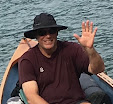
Greetings, Gentle Reader,
I’ve been varnishing the boat of late…getting the wood back into shape after too many years and miles of neglect. I’m not particularly handy, and yet this work has been uniquely satisfying: sanding lightly with the 150 grit…tack-clothing…sanding again with the finer 220 grit…tack clothing…applying a coat of spar varnish…cleaning up the spills and spatters….and then repeating the process after drying (four times). Sounds tedious, right? I, too, thought that it would be, but it’s gratifying to see some great wood saved, and it’s humbling to see how even my most fastidious effort pales in comparison to the original great work of the folks at Adirondack Guideboat.
As a teacher I have come to learn that the best learning is both hands-on and inviting of error, right? With this in mind, let me tell you about my first-ever attempt at varnishing.
I started at the stern, thinking I would hazard a small “test patch” to see if I should try my hand at the rest of the woodwork on the boat. I sanded the short stern deck and about two feet of gunwale on both sides. I did this with great trepidation. I’ve never vandalized another’s work before, and in fooling with the even-now imperfect original finish of my boat, I felt I was messing with a religious artifact.
I sanded carefully. I tack-clothed. I sanded again, delicately. More tack-cloth. Then, I varnished.
Voila! Yowee-Zowee! Woah! Lookin’ good! Oh, yes, I can do this!
Emboldened by this promising result and fueled by the impetuosity of youth and inexperience, I kept going, sanding and tack- clothing all the way to the bow. Head down, singularly focused on the wood in front of me, I labored with the intensity of an old-world craftsman (or a wanna-be Adirondack Guideboat boatbuilder), even enjoying the attention of street passers-by as they beheld what, to the layperson, seemed to be artisan at his craft. “Wow, he’s varnishing a boat!” I could hear them thinking. “How do you learn to do that? I wish I knew how to do that! That’s not a skill…it’s a gift from God.”
Of course, Gentle Readers who are experienced woodworkers like you, Brian, will immediately recognize my error just as I did when I finally stood up to wipe my brow and behold the wonder of my work. Oh, fecal matter! Each and every dust particle I had loosed from the wood during Phase Two now clung desperately to the fresh varnish of the test patch. (Yes, Brian, a suspended “dust” particle takes on the size of a marble when it hits fresh varnish.) If you had complexion problems as a kid or knew a kid who did, you can immediately picture the texture of the varnish I had applied. The formerly smooth, gleaming, seamless deck was now a picture-perfect non-skid surface, each embedded granule mocking me. “Why did you do that?” I heard them say as one. “Only an idiot would do that! That’s not a varnish job…it’s a testament to your childish impatience!”
Lesson learned, of course: Sand it all, then varnish.
I hit “reset” and started it all again the next day, and while I’m not finished, I remain hopeful. But I’m not about to submit my application to Adirondack Guide Boat anytime soon. Nor should they read it if I change my mind.
Gentle Reader, this is indeed the last blog. Kathy tells me she might put all this in booklet form as she did for “The Big Row”, complete with some unpublished photos. Let me know if you’re interested. I thought her earlier inclusion of the Roy Orbison piece was especially poignant and hope that there’s a possibility that, when the last page is turned, a Hallmark-esque Roy might cap the hard-copy reading experience. It would be hokey, but sweet.
Thanks once again to the donors, to Kathy for her wonderful stewardship of the blog, to you who encourage me and, of course, to Peg. I am one lucky fellah.
Varnishing…and now vanishing…for now.
Big Hugs, Big Ups,
Mr. Frei













